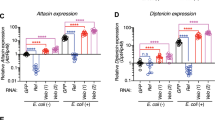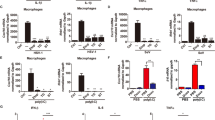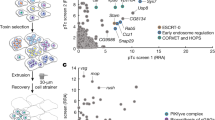Abstract
A few years ago, it would have been difficult to argue that elucidating the mechanisms of disease resistance in the fruit fly, Drosophila melanogaster, would provide new insights into mammalian immunity. Yet the finding that the Drosophila protein Toll mediates immune responses to fungal infection had a pioneering role in the identification of Toll-like receptors as essential regulators of mammalian host defence, and it fundamentally altered our understanding of innate immunity. In this Landmark article, I describe the thought processes and the experimental steps that defined Toll as a key regulator of Drosophila immune responses.
This is a preview of subscription content, access via your institution
Access options
Subscribe to this journal
Receive 12 print issues and online access
$209.00 per year
only $17.42 per issue
Buy this article
- Purchase on Springer Link
- Instant access to full article PDF
Prices may be subject to local taxes which are calculated during checkout



Similar content being viewed by others
References
Steiner, H., Hultmark, D., Engstrom, A., Bennich, H. & Boman, H. G. Sequence and specificity of two antibacterial proteins involved in insect immunity. Nature 292, 246–248 (1981).
Hultmark, D. et al. Insect immunity. Attacins, a family of antibacterial proteins from Hyalophora cecropia. EMBO J. 2, 571–576 (1983).
Samakovlis, C., Kimbrell, D., Kylsten, P., Engstrom, A. & Hultmark, D. The immune response in Drosophila: pattern of Cecropin expression and biological activity. EMBO J. 9, 2969–2976 (1990).
Kylsten, P., Samakovlis, C. & Hultmark, D. The cecropin locus in Drosophila; a compact gene cluster involved in the response to infection. EMBO J. 9, 217–224 (1990).
Wicker, C. et al. Insect immunity. Characterization of a Drosophila cDNA encoding a novel member of the Diptericin family of immune peptides. J. Biol. Chem. 265, 22493–22498 (1990).
Sun, S. C., Lindstrom, I., Lee, J. Y. & Faye, I. Structure and expression of the attacin genes in Hyalophora cecropia. Eur. J. Biochem. 196, 247–254 (1991).
Kappler, C. et al. Insect immunity. Two 17bp repeats nesting a κB-related sequence confer inducibility to the Diptericin gene and bind a polypeptide in bacteria-challenged Drosophila. EMBO J. 12, 1561–1568 (1993).
Engstrom, Y. et al. κB-like motifs regulate the induction of immune genes in Drosophila. J. Mol. Biol. 232, 327–333 (1993).
Li, Q. & Verma, I. M. NF-κB regulation in the immune system. Nature Rev. Immunol. 2, 725–734 (2002).
Gay, N. & Keith, F. Drosophila Toll and IL-1 receptor. Nature 351, 355–356 (1991).
Schneider, D. S., Hudson, K. L., Lin, T. Y. & Anderson, K. V. Dominant and recessive mutations define functional domains of Toll, a transmembrane protein required for dorsal–ventral polarity in the Drosophila embryo. Genes Dev. 5, 797–807 (1991).
Heguy, A., Baldari, C. T., Macchia, G., Telford, J. L. & Melli, M. Amino acids conserved in interleukin-1 receptors (IL-1Rs) and the Drosophila Toll protein are essential for IL-1R signal transduction. J. Biol. Chem. 267, 2605–2609 (1992).
Nusslein-Volhard, C. in Determinants of Spatial Organization (eds Subtelny, S. & Konigsberg, I. R.) 185–211 (Academic, New York, 1979).
Steward, R. Dorsal, an embryonic polarity gene in Drosophila is homologous to the vertebrate proto-oncogene c-rel. Science 238, 692–694 (1987).
Ip, Y. T., Kraut, R., Levine, M. & Rushlow, C. A. The Dorsal morphogen is a sequence-specific DNA-binding protein that interacts with a long-range repression element in Drosophila. Cell 64, 439–446 (1991).
Thisse, C., Perrin-Schmitt, F., Stoetzel, C. & Thisse, B. Sequence-specific transactivation of the Drosophila twist gene by the dorsal gene product. Cell 65, 1191–1201 (1991).
Pan, D. J., Huang, J. D. & Courey, A. J. Functional analysis of the Drosophila twist promoter reveals a dorsal-binding ventral activator region. Genes Dev. 5, 1892–1901 (1991).
Gerttula, S., Jin, Y. S. & Anderson, K. V. Zygotic expression and activity of the Drosophila Toll gene, a gene required maternally for embryonic dorsal–ventral pattern formation. Genetics 119, 123–133 (1988).
Letsou, A., Alexander, S., Orth, K. & Wasserman, S. A. Genetic and molecular characterization of tube, a Drosophila gene maternally required for embryonic dorsoventral polarity. Proc. Natl Acad. Sci. USA 88, 810–814 (1991).
Hecht, P. M. & Anderson, K. V. Genetic characterization of tube and pelle, genes required for signaling between Toll and Dorsal in the specification of the dorsal–ventral pattern of the Drosophila embryo. Genetics 135, 405–417 (1993).
Reichhart, J. M. et al. Expression and nuclear translocation of the rel/NF-κB-related morphogen Dorsal during the immune response of Drosophila. C. R. Acad. Sci. III, Sci. Vie 316, 1218–1224 (1993).
Lemaitre, B. et al. Functional analysis and regulation of nuclear import of Dorsal during the immune response in Drosophila. EMBO J. 14, 536–545 (1995).
Ip, Y. et al. Dif, a dorsal-related gene that mediates an immune response in Drosophila. Cell 75, 753–763 (1993).
Rosetto, M., Engstrom, Y., Baldari, C. T., Telford, J. L. & Hultmark, D. Signals from the IL-1 receptor homolog, Toll, can activate an immune response in a Drosophila hemocyte cell line. Biochem. Biophys. Res. Commun. 209, 111–116 (1995).
Fehlbaum, P. et al. Insect immunity: septic injury of Drosophila induces the synthesis of a potent antifungal peptide with sequence homology to plant antifungal peptides. J. Biol. Chem. 269, 33159–33163 (1994).
Rizki, T., Rizki, R. & Grell, E. A mutant affecting the crystal cells in Drosophila melanogaster. Rouxs Arch. Dev. Biol. 188, 91–99 (1980).
Söderhäll, K. & Cerenius, L. Role of prophenoloxidase-activating system in invertebrate immunity. Curr. Opin. Immunol. 10, 23–28 (1998).
Lemaitre, B. et al. A recessive mutation, immune deficiency (imd), defines two distinct control pathways in the Drosophila host defense. Proc. Natl Acad. Sci. USA 92, 9465–9469 (1995).
Corbo, J. C. & Levine, M. Characterization of an immunodeficiency mutant in Drosophila. Mech. Dev. 55, 211–220 (1996).
Lemaitre, B., Nicolas, E., Michaut, L., Reichhart, J. & Hoffmann, J. The dorsoventral regulatory gene cassette spätzle/Toll/cactus controls the potent antifungal response in Drosophila adults. Cell 86, 973–983 (1996).
Chasan, R. & Anderson, K. V. The role of Easter, an apparent serine protease, in organizing the dorsal–ventral pattern of the Drosophila embryo. Cell 56, 391–400 (1989).
Meng, X., Khanuja, B. S. & Ip, Y. T. Toll receptor-mediated Drosophila immune response requires Dif, an NF-κB factor. Genes Dev. 13, 792–797 (1999).
Rutschmann, S. et al. The Rel protein DIF mediates the antifungal but not the antibacterial host defense in Drosophila. Immunity 12, 569–580 (2000).
Lemaitre, B., Reichhart, J. & Hoffmann, J. Drosophila host defense: differential induction of antimicrobial peptide genes after infection by various classes of microorganisms. Proc. Natl Acad. Sci. USA 94, 14614–14619 (1997).
Dushay, M., Asling, B. & Hultmark, D. Origins of immunity: Relish, a compound Rel-like gene in the antibacterial defense of Drosophila. Proc. Natl Acad. Sci. USA 93, 10343–10347 (1996).
Hedengren, M. et al. Relish, a central factor in the control of humoral but not cellular immunity in Drosophila. Mol. Cell 4, 827–837 (1999).
Wu, L. P. & Anderson, K. V. Regulated nuclear import of Rel proteins in the Drosophila immune response. Nature 392, 93–97 (1998).
Leulier, F., Rodriguez, A., Khush, R. S., Abrams, J. M. & Lemaitre, B. The Drosophila caspase Dredd is required to resist Gram-negative bacterial infection. EMBO Rep. 1, 353–358 (2000).
Rutschmann, S. et al. Role of Drosophila IKKγ in a Toll-independent antibacterial immune response. Nature Immunol. 1, 342–347 (2000).
Elrod-Erickson, M., Mishra, S. & Schneider, D. Interactions between the cellular and humoral immune responses in Drosophila. Curr. Biol. 10, 781–784 (2000).
Lu, Y., Wu, L. P. & Anderson, K. V. The antibacterial arm of the Drosophila innate immune response requires an IκB kinase. Genes Dev. 15, 104–110 (2001).
Vidal, S. et al. Mutations in the Drosophila dTAK1 gene reveal a conserved function for MAPKKKs in the control of rel/NF-κB-dependent innate immune responses. Genes Dev. 15, 1900–1912 (2001).
Choe, K. M., Werner, T., Stoven, S., Hultmark, D. & Anderson, K. V. Requirement for a peptidoglycan recognition protein (PGRP) in Relish activation and antibacterial immune responses in Drosophila. Science 296, 359–362 (2002).
Silverman, N. et al. A Drosophila IκB kinase complex required for Relish cleavage and antibacterial immunity. Genes Dev. 14, 2461–2471 (2000).
Stöven, S., Ando, I., Kadalayil, L., Engström, Y. & Hultmark, D. Activation of the Drosophila NF-κB factor Relish by rapid endoproteolytic cleavage. EMBO Rep. 1, 347–352 (2000).
Georgel, P. et al. Drosophila immune deficiency (IMD) is a death domain protein that activates antibacterial defense and can promote apoptosis. Dev. Cell 1, 503–514 (2001).
Leulier, F., Vidal, S., Saigo, K., Ueda, R. & Lemaitre, B. Inducible expression of double-stranded RNA reveals a role for dFADD in the regulation of the antibacterial response in Drosophila adults. Curr. Biol. 12, 996–1000 (2002).
Naitza, S. et al. The Drosophila immune defense against Gram-negative infection requires the death protein dFADD. Immunity 17, 575–581 (2002).
Medzhitov, R., Preston-Hurlburt, P. & Janeway, C. A human homologue of the Drosophila Toll protein signals activation of adaptive immunity. Nature 388, 394–397 (1997).
Akira, S. Mammalian Toll-like receptors. Curr. Opin. Immunol. 15, 5–11 (2003).
Beutler, B., Hoebe, K., Du, X. & Ulevitch, R. J. How we detect microbes and respond to them: the Toll-like receptors and their transducers. J. Leukoc. Biol. 74, 479–485 (2003).
Weber, A. N. et al. Binding of the Drosophila cytokine Spatzle to Toll is direct and establishes signaling. Nature Immunol. 4, 794–800 (2003).
Tauszig, S., Jouanguy, E., Hoffmann, J. A. & Imler, J. L. Toll-related receptors and the control of antimicrobial peptide expression in Drosophila. Proc. Natl Acad. Sci. USA 97, 10520–10525 (2000).
Imler, J. L. & Hoffmann, J. A. Toll receptors in Drosophila: a family of molecules regulating development and immunity. Curr. Top. Microbiol. Immunol. 270, 63–79 (2002).
Ooi, J. Y., Yagi, Y., Hu, X. & Ip, Y. T. The Drosophila Toll-9 activates a constitutive antimicrobial defense. EMBO Rep. 3, 82–87 (2002).
Michel, T., Reichhart, J. M., Hoffmann, J. A. & Royet, J. Drosophila Toll is activated by Gram-positive bacteria through a circulating peptidoglycan recognition protein. Nature 414, 756–759 (2001).
Ramet, M., Manfruelli, P., Pearson, A., Mathey-Prevot, B. & Ezekowitz, R. A. Functional genomic analysis of phagocytosis and identification of a Drosophila receptor for E. coli. Nature 416, 644–648 (2002).
Gottar, M. et al. The Drosophila immune response against Gram-negative bacteria is mediated by a peptidoglycan recognition protein. Nature 416, 640–644 (2002).
Gobert, V. et al. Dual activation of the Drosophila Toll pathway by two pattern recognition receptors. Science 302, 2126–2130 (2003).
Pili-Floury, S. et al. In vivo RNA interference analysis reveals an unexpected role for GNBP1 in the defense against Gram-positive bacterial infection in Drosophila adults. J. Biol. Chem. 279, 12848–12853 (2004).
Yoshida, H., Kinoshita, K. & Ashida, M. Purification of a peptidoglycan recognition protein from hemolymph of the silkworm, Bombyx mori. J. Biol. Chem. 271, 13854–13860 (1996).
Lee, W., Lee, J., Kravchenko, V., Ulevitch, R. & Brey, P. Purification and molecular cloning of an inducible Gram-negative bacteria-binding protein from the silkworm, Bombyx mori. Proc. Natl Acad. Sci. USA 93, 7888–7893 (1996).
Ochiai, M. & Ashida, M. A pattern recognition protein for peptidoglycan. Cloning the cDNA and the gene of the silkworm, Bombyx mori. J. Biol. Chem. 274, 11854–11858 (1999).
Kang, D., Liu, G., Lundstrom, A., Gelius, E. & Steiner, H. A peptidoglycan regonition protein in innate immunity conserved from insects to humans. Proc. Natl Acad. Sci. USA 95, 10078–10082 (1998).
Leulier, F. et al. The Drosophila immune system detects bacteria through specific peptidoglycan recognition. Nature Immunol. 4, 478–484 (2003).
Rubin, G. M. et al. Comparative genomics of the eukaryotes. Science 287, 2204–2215 (2000).
Anderson, K. V. & Nusslein-Volhard, C. in Pattern Formation: A Primer in Developmental Biology (eds Malacinski, G. M. & Bryant, S. V.) 269–289 (Macmillan, New York, 1984).
Anderson, K. V., Bokla, L. & Nusslein-Volhard, C. Establishment of dorsal–ventral polarity in the Drosophila embryo: the induction of polarity by the Toll gene product. Cell 42, 791–798 (1985).
Anderson, K. V., Jurgens, G. & Nusslein-Volhard, C. Establishment of dorsal–ventral polarity in the Drosophila embryo: genetic studies on the role of the Toll gene product. Cell 42, 779–789 (1985).
Hashimoto, C., Hudson, K. & Anderson, K. The Toll gene of Drosophila, required for dorsal–ventral embryonic polarity, appears to encode a transmembrane protein. Cell 52, 269–279 (1988).
Hashimoto, C., Kim, D. R., Weiss, L. A., Miller, J. W. & Morisato, D. Spatial regulation of developmental signaling by a serpin. Dev. Cell 5, 945–950 (2003).
Ligoxygakis, P., Roth, S. & Reichhart, J. M. A serpin regulates dorsal–ventral axis formation in the Drosophila embryo. Curr. Biol. 13, 2097–2102 (2003).
Kambris, Z. et al. DmMyD88 controls dorsoventral patterning of the Drosophila embryo. EMBO Rep. 4, 64–69 (2003).
Charatsi, I., Luschnig, S., Bartoszewski, S., Nusslein-Volhard, C. & Moussian, B. Krapfen/dMyd88 is required for the establishment of dorsoventral pattern in the Drosophila embryo. Mech. Dev. 120, 219–226 (2003).
Belvin, M. P. & Anderson, K. V. A conserved signaling pathway: the Drosophila Toll–Dorsal pathway. Annu. Rev. Cell Dev. Biol. 12, 393–416 (1996).
Qiu, P., Pan, P. C. & Govind, S. A role for the Drosophila Toll/Cactus pathway in larval hematopoiesis. Development 125, 1909–1920 (1998).
Hultmark, D. Drosophila immunity: paths and patterns. Curr. Opin. Immunol. 15, 12–19 (2003).
Ferrandon, D., Imler, J. L. & Hoffmann, J. A. Sensing infection in Drosophila: Toll and beyond. Semin. Immunol. 16, 43–53 (2004).
Acknowledgements
I thank Jules Hoffmann and all of my former colleagues for the stimulating and encouraging environment in Strasbourg, France, and Nicolas Vodovar for providing the original illustration of figure 3. I am also indebted to the generous spirit of the Drosophila-research community, including Kathy Matthews at the Bloomington Stock Center, Bloomington, United States, and Iris Koch and Dirk Beuchle at the Tübingen Stock Centre, Tübingen, Germany, for providing the many fly stocks that made this work possible. My laboratory is supported by the Centre National de la Recherche Scientifique, France, and the Schlumberger and Bettencourt Foundations, France.
Author information
Authors and Affiliations
Ethics declarations
Competing interests
The author declares no competing financial interests.
Related links
Related links
DATABASES
Entrez Gene
FlyBase
FURTHER INFORMATION
Rights and permissions
About this article
Cite this article
Lemaitre, B. The road to Toll. Nat Rev Immunol 4, 521–527 (2004). https://doi.org/10.1038/nri1390
Issue Date:
DOI: https://doi.org/10.1038/nri1390
This article is cited by
-
An insight in proteome profiling of Tuta absoluta larvae after entomopathogenic fungal infection
Scientific Data (2022)
-
The Intruding Wolbachia Strain from the Moth Fails to Establish Itself in the Fruit Fly Due to Immune and Exclusion Reactions
Current Microbiology (2020)
-
Association of TLR1, TLR2, TLR4, TLR6, and TIRAP polymorphisms with disease susceptibility
Immunologic Research (2015)
-
Zur Rolle des angeborenen Immunsystems bei atopischer Dermatitis
Der Hautarzt (2015)
-
Innate versus adaptive immunity in kidney immunopathology
BMC Nephrology (2013)



